Along the cobbled, narrow streets of Assisi one discovers stories of saints and pilgrims who have lived, loved and suffered here. As you walk along them the soul surrenders, but the Umbrian city, home of St . Francis and St. Clare, is not only a story of spirituality: it is also an embrace of wild and lush nature where the hills are lost far to the eye, giving enchanting landscapes that are always the same and different. Every step reveals hidden secrets, hushed for endless time, and the stone walls speak of the tearing run of history. The origins of the city are firmly tied to the legend of Dardanus, a mythological figure whose lineage founded the city of Troy. It is said that he had the city of Assisi built as many as eight centuries before Rome and erected a temple, now a symbol of the city’s classical period, in honor of Minerva, goddess of war and wisdom. And this is where our journey into 10 places to visit in Assisi will begin.
This ancient temple, dating back to the first century B.C., is now an integral part of the church of Santa Maria sopra Minerva and it is also thanks to this that it has managed to survive history. The facade, still in its original state, has six columns with Corinthian capitals resting on plinths that, due to lack of space, were placed on the steps. It was in the medieval age that the temple was converted into a Christian church and, from 1212, was used first as the residence of the Podestà, then as a civic court and municipal prison until, in 1456, it returned to religious use. The constant change of use led to several changes over the centuries such as that 1539 , in which the cell was broken through to accommodate the present church of Santa Maria sopra Minerva, which was further modified in Baroque style in the 17th century. Only recently, however, has a short section of the temple near the altar been rediscovered, with a walled arch now visible, as well as part of the ancient Roman pavement and the rear terracing wall.
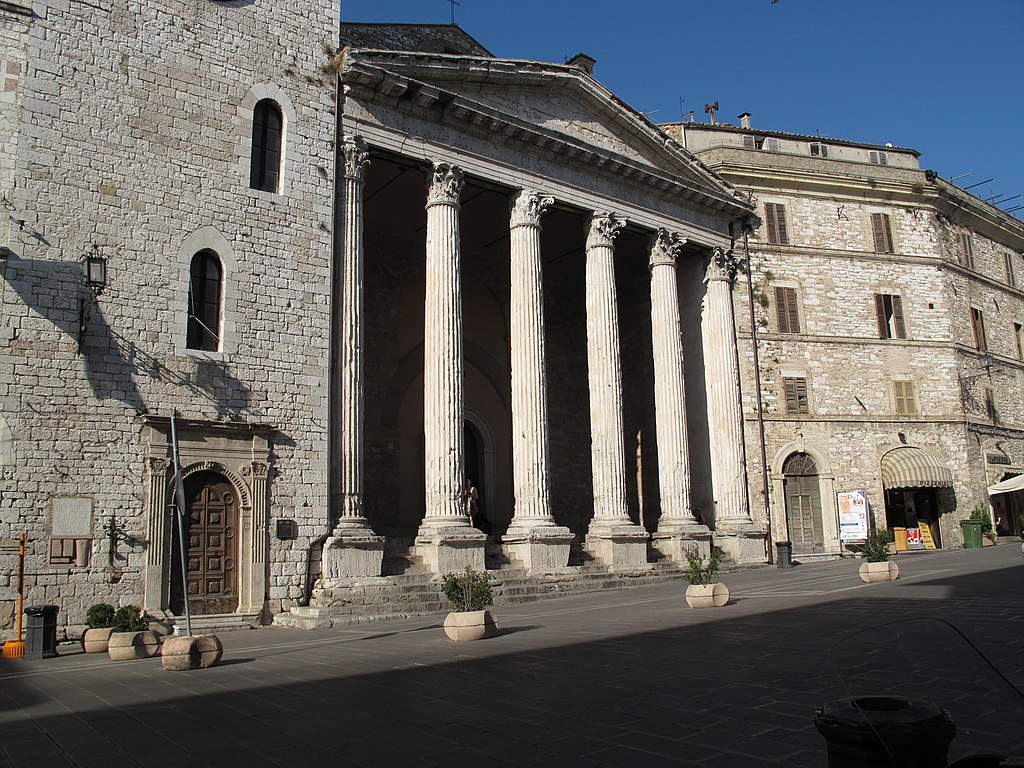
Although a column is missing, the very Temple of Minerva seems to be the inspiration for the fresco in the Basilica of St. Francis, which scholars believe could be attributable either to Giotto, who between 1303 and 1311 was in Assisi to fresco the vault, the right transept and the Magdalene Chapel of the Lower Basilica, or, according to restorer Bruno Zanardi and art critic Federico Zeri, it could belong to a group of Roman painters coordinated perhaps by Jacopo Torriti or Pietro Cavallini. What we know with greater certainty is that the lower church is decorated with frescoes by Cimabue, Lorenzetti, Sermei and the Umbrian artist known as the “Master of St. Francis.” Cimabue worked there between 1288 and 1292: in the apse are the stories of Mary, in the left transept are the stories of the apocalypse and the first of the two Crucifixions, and in the right transept are the stories of Saints Peter and Paul and the second Crucifixion. Later, in the 14th century, Simone Martini and Pietro Lorenzetti worked there. The great history of art, in short, passed through here.

About a kilometer away from the Basilica of St. Francis stands the one dedicated to St. Clare, co-founder of the Poor Clare order. Inside the basilica, whose exterior is banded in pink and white Subasio stone, are the body of St. Clare, works of art by Puccio Capanna and a very precious Crucifix. The latter is now kept in the chapel of St. George and is the same 12th-century Byzantine-style Crucifix that, in the church of San Damiano, spoke to the young Francis. Behind it, the chapel is adorned with 14th-century frescoes among which stands out Puccio Capanna’s Majesty of 1335, which depicts the Virgin Enthroned with the Blessing Child, St. Clare and St. John the Baptist on the left and St. Michael the Archangel and St. Francis on the right.The basilica’s interior was originally intended to be completely frescoed, while today it is clear and almost bare in its single-nave Latin cross structure with polygonal apse.
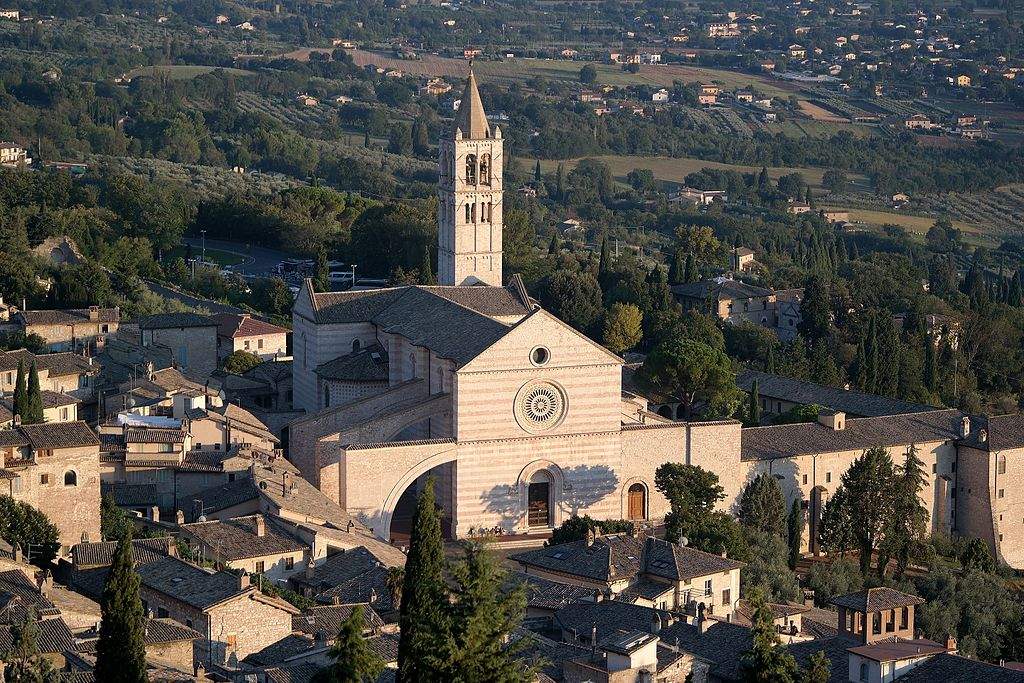
Imposing and austere, the medieval fortress, towers over the historic center of Assisi, looking down on it from above and offering visitors a striking panorama overlooking the hills and the gorge crossed by the Tescio River. The earliest historical records reach us in 1173- 1174 when the archbishop of Mainz, Cristiano, stayed there and occupied Assisi on behalf of Frederick Barbarossa, but in 1198 it was completely razed to the ground by a popular uprising. From here, the fortress remained in a state of neglect until, in 1362, Cardinal Egidio Albornoz decided to rebuild it on the basis of the ancient fortification. The 14th-century building with a square plan, main tower and angled keep, was supplemented by a system of walls equipped with towers over the centuries, and the last intervention would be carried out in 1535, when Pope Paul III had the circular bastion built.

The Romanesque cathedral is one of Assisi’s principal religious buildings and probably occupied part of the Roman terrace on which the temple of the Bona Mater stood. A plaque on the outside of the apse records that work on the new temple, carried out to the design of master Giovanni da Gubbio, was begun in 1140 "In the year of our Lord 1140 and on the end of the fourth month of April, this cathedral was begun and conducted providing for the expenses the prior Raniero in honor of S. Rufino, and Giovanni da Gubbio, who was master in this cathedral first dictated the design and, as long as he lived, presided over its erection." But conflicts between neighboring cities and discord among citizens of opposing factions greatly lengthened the time it took to build the church, which was fully consecrated in 1253 by Innocent IV. Its facade, tripartite by pilasters, represents one of the finest examples of Romanesque architecture in Central Italy. It is divided into three orders marked by a faux loggia, in which in the lower order open the three finely carved portals and in the main one, flow intertwined shoots, overlapping columns, characters intent on gathering fruit, monstrous animals and pairs of dancing men and women.
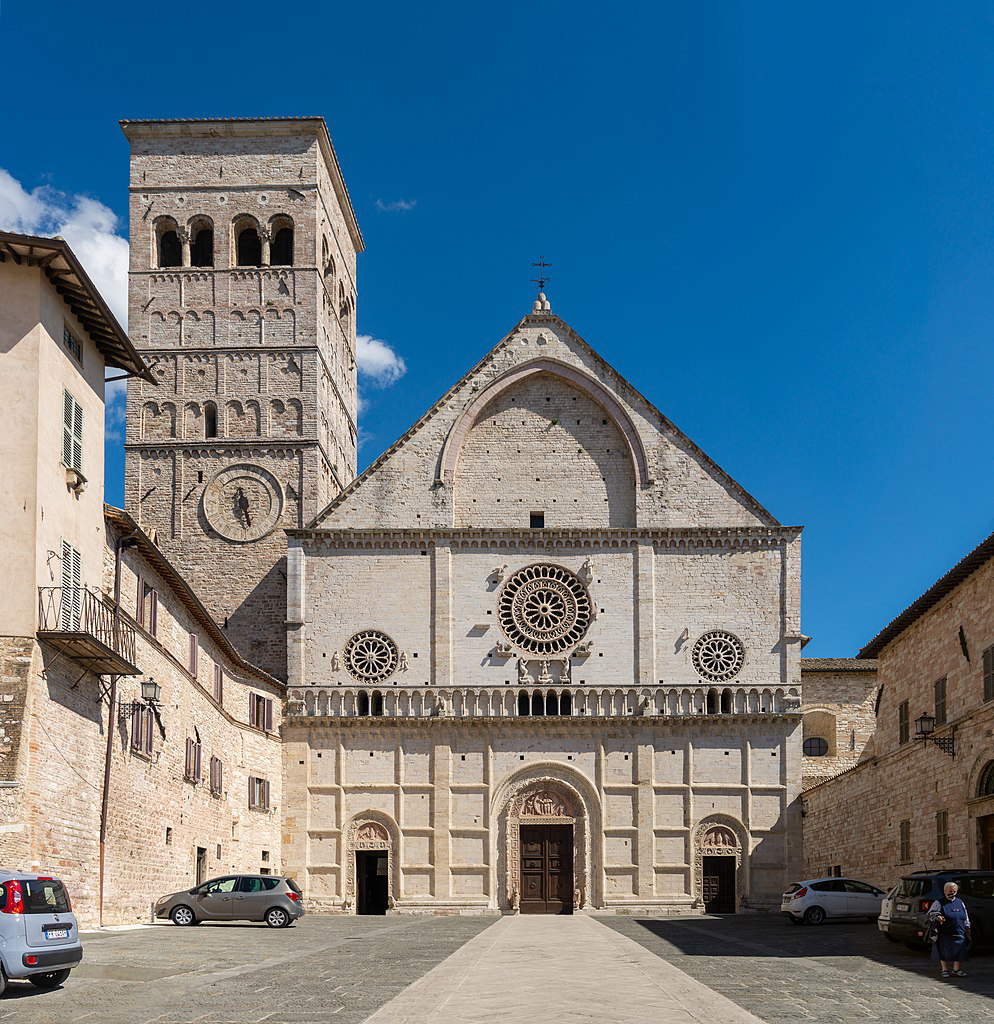
A small hidden treasure that is definitely worth a visit is also the Oratory of the Pilgrims, decorated inside with valuable paintings and frescoes by Matteo da Gualdo, Pierantonio da Foligno and Andrea d’Assisi, a pupil of Perugino. Built during the 15th century, it was created for the specific purpose of a hostel to house pilgrims and was therefore consecrated to Saints Anthony Abbot and James of Compostela. Just behind the altar is one of two frescoes by Matteo da Gualdo representing the Madonna and Child between St. Anthony Abbot and St. James of Compostela, while the second fresco is on the facade of the building, but is, unfortunately, in poor condition. Also inside the oratory, among other decorations, is “The Great Pilgrim’s Miracle,” in which St. James resurrects two cockerels to prove the innocence of a young man sentenced to death for stealing a silver cup.

A small treasure chest of artistic treasures is the Pinacoteca Comunale (Municipal Picture Gallery), which is located inside Palazzo Vallemani, a Baroque mansion with vaults frescoed in the early 17th century by Umbrian and Tuscan painters. The palace was the residence of the noble Giacobetti family and later of the Vallemani family. The collection was created in the late 19th century with the intention of preserving the town’s artistic heritage, creating an extremely unusual itinerary of Assisi linked, not only to religion, but also to its political and civic evolution. The museum houses a collection of medieval and Renaissance frescoes from civil and religious buildings in and around Assisi, from the Middle Ages to the Renaissance, and it is possible to admire a Majesty attributed to Giotto and paintings by artists such as Simone Martini, Pinturicchio and Perugino.
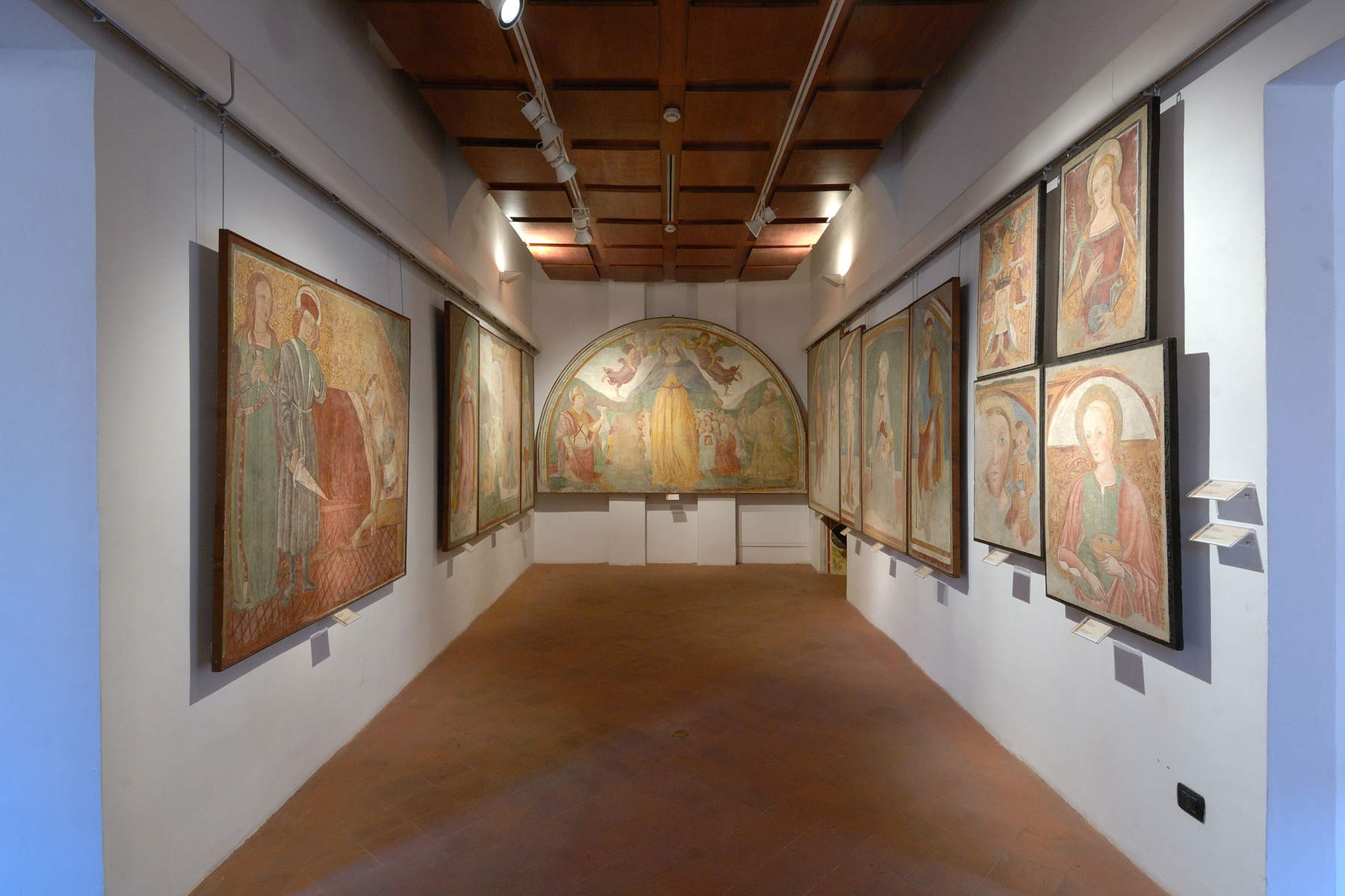
Built on the site where tradition indicates the home of St. Francis, the New Church, was transformed into a place of worship in 1615 by the Friars Minor with the financial contribution of Philip III King of Spain. Dedicated to the conversion of the Poor Man of Assisi, it features a crawl space in which Pietro di Bernardone allegedly locked up his son after fleeing to Foligno to sell cloth in order to succeed in repairing the church of San Damiano. The Chiesa Nuova also features the fondaco where the young Francis became skilled in the practice of merchandise. Outside the building, on the small square in front, are two statues representing the parents of St. Francis that are celebrated, every year, on the second Sunday in September.

The imposing medieval Palazzo dei Priori stands on the Piazza del Comune, which was the political and cultural hub of the city of Assisi. The building saw the light of day in 1275 and was created with the idea of merging the pre-existing buildings of the Palazzo del Capitano del Popolo and the Palazzo dei Governatori into one. Two centuries later, in 1442, it was severely damaged during a military uprising and nearly razed to the ground by the papal militia, coming from Perugia and led by Niccolò Piccino. Fortunately, the palace was rebuilt at the behest of Pope Sixtus IV, who designated it as the seat of the papal governor and bank of piety, and from this time on, numerous stores opened on the lower floor. On the facade are various coats of arms dating from the mid-15th century, including that of Sixtus IV himself, and where the Governor’s Palace once stood, a passageway from the barrel vault richly decorated with grotesques was created in 1556.
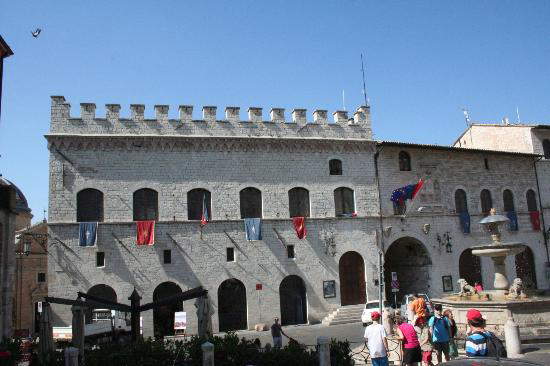
Isolated from the Umbrian Valley stands Mount Subasio, Assisi’s mountain consisting of carbonate sedimentary rock, which exogenous phenomena have shaped over time, creating a shape that many confuse with that of a volcano. Numerous fossils have been found on this mountain, which are now on display at the Geo-Paleontology Ecological Laboratory inside the park. The museum is divided into three halls where, in the first, the processes of fossil formation are explained, the second narrates and analyzes the rocks and fossils of the area, and the third deals with various topics such as reptiles and fossils of the Mesozoic age, the comparison between the Jurassic of Umbria and the rest of Europe, and the extinction of dinosaurs.
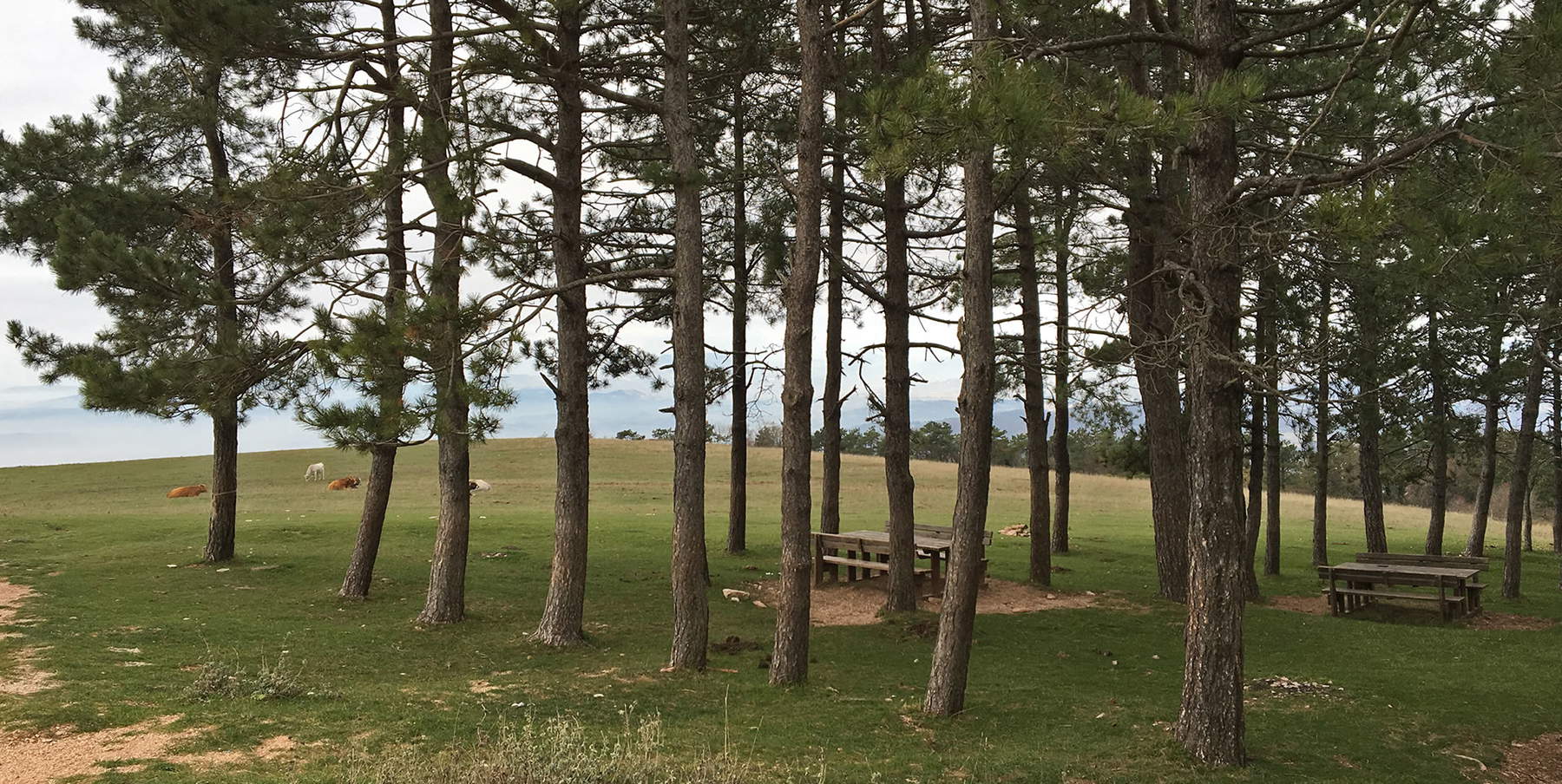
 |
| Assisi, what to see: 10 places not to miss |
Warning: the translation into English of the original Italian article was created using automatic tools. We undertake to review all articles, but we do not guarantee the total absence of inaccuracies in the translation due to the program. You can find the original by clicking on the ITA button. If you find any mistake,please contact us.